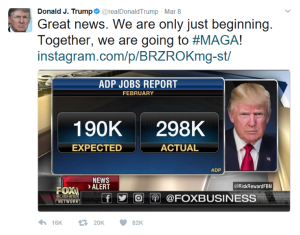The U.S. economy appears to be firing on all cylinders. At least that’s the message if you look at the most recent jobs report. This portends good things for small cap stocks in 2017.
As I wrote in mid-February, since 1986 when GDP growth is in the 2% to 3% range, small caps have been up 100% of the time. A strong job market will help GDP land in that range.
Last Wednesday, ADP reported that private payrolls rose by 298,000 in February. That was 100,000 better than expected. President Trump didn’t waste any time sharing the success story on Twitter.
Then Friday’s nonfarm payroll report was expected to show an increase of 197,000 last month. It showed 235,000. Again, President Trump helped to spread the word.
We’ve had 17 consecutive months of unemployment below 5%, and trailing three-month average payroll growth of 183,000. Over the last three months, monthly average job growth has been 209,000.
The strong job market is expected to help justify a fed rate hike later this week. In fact, it’s safe to say no movement on interest rates would come as quite a surprise to the market given that futures currently price in a better-than-90% chance of a hike.
If the fed hikes it will mark just the third increase since the financial crisis. This trend is good for small caps too - data from Fidelity dating back to 1979 shows that small caps have enjoyed an average 12-month gain of 14% when long-term rates rise by 1%.
Workforce Management Software is a Fragmented Market
There are many ways investors can play the massive global job market. But before I get into specific stocks, just step back for a minute and think about how big this industry is.
[text_ad]
There are over 7 billion people in the world, and more than 3 billion of them are employed. Hundreds of millions more are submitting resumes and looking for jobs. In the U.S. alone there are 120 million full-time employees. Millions more have part-time jobs.
All the companies employing these people need a payroll processing solution. Many also need solutions to manage benefits, human resources (HR) and talent. This is one area to look for investment ideas.
Their need is constant; every minute of every day some payroll or benefit item accrues. Health care coverage changes every year. Flexible Spending Accounts (FSAs) and Health Savings Accounts (HSAs) add a layer of complexity. Then there are taxes. In the U.S., there are over 15,000 tax codes. And on average, there is a change to the code every single day.
The need to handle all the above has given rise to a category of software known as Human Capital Management (HCM). HCM software helps enterprises handle the complexity of HR, payroll, benefits and talent management, while also helping employees navigate through the web of confusion. HCM is a massive global market worth $12 billion today, and it’s estimated to be growing at around 8% annually.
It’s also an extremely fragmented market, with an estimated 40% of companies relying on very small and limited point source solutions (as opposed to enterprise solutions). That means there is a lot of room for providers to grow. But they have to remain nimble too.
The HCM market is changing rapidly. Employees around the world have become increasingly mobile. That means next-generation HCM solutions need flexibility, which means moving to the cloud so employees, managers and executives can access solutions from anywhere.
It also means that HCM needs to expand beyond payroll, benefits and talent management to encompass dynamic workforces that no longer arrive at the office and work from nine to five. Some employees never set foot in the office, while others are there sporadically. Having a dedicated desk for every worker is a waste of real estate and money. Yet not having a meeting space available when needed is also a big problem.
Managing an agile, global workforce requires a Workplace Management System, which is a different type of software than HCM. Workplace Management software can help seat more workers at fewer desks, maximize utilization of meeting rooms, and help manage moves and expansions.
Having both an HCM and Workplace Management solutions can help companies address some of the major changes taking place in the global job market.
Like the reality that over 70% of businesses are managing teams across borders, 58% are implementing HR policies to address a global workforce, and 55% are sourcing key talent outside of their home market.
And that flexible work schedules and telecommuting are on the rise. At the same time, even remote workers visit an office occasionally. The practical challenge today is that around 50% of desks, offices and workstations in traditional offices are unused at any given point in a typical workday.
Gartner says that an individual employee’s workspace costs an organization $8,000 to $14,000 a year. Cutting 100 workspaces could save $1 million annually. That’s a reality that every company that doesn’t enforce a strict in-office work policy needs to consider.
The Best Small Cap Stock to Play a Strong Labor Market
The trend is toward using cloud-based software to manage both human capital and mobile workforces. There are a number of companies that do one or the other. These include Paycom (PAYC), Ultimate Software (ULTI) and Automatic Data Processing (ADP). Cornerstone OnDemand (CSOD) is another.
But these companies don’t cover both HCM and Workplace Management solutions. In fact, to my knowledge there is only one company SaaS-based company that covers both. And I just sent a report detailing the company’s potential to Cabot Small-Cap Confidential subscribers.
It’s growing revenue by 40%, and it’s profitable. Yet its market cap is still well below $500 million, making it a small cap stock. I expect that to change as the market becomes more aware of this undiscovered company.
Its products stand out in a fragmented industry because they span both HCM and workplace solutions. That means customers that use its software to manage payroll, benefits and hiring can easily turn on solutions to manage how, when and where their people work, what assets they use, and what rooms they need. No shopping around for another company required.
Managing today’s global workforce is no small task. But this unknown company is up to the challenge, nipping at the heels of its larger competitors and grabbing market share. To get all the details, grab a subscription to Cabot Small-Cap Confidential today. It’s just one of many small cap stocks that are helping us make money in a strong U.S. economy.
[author_ad]


